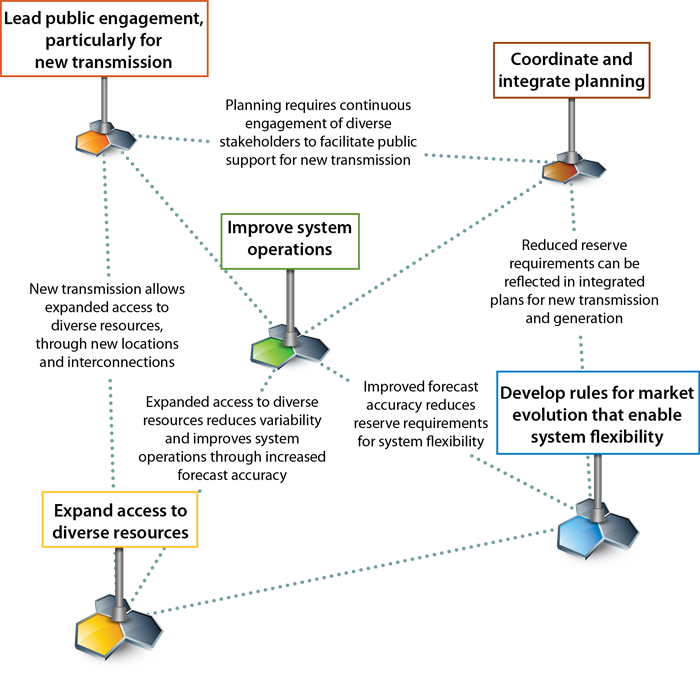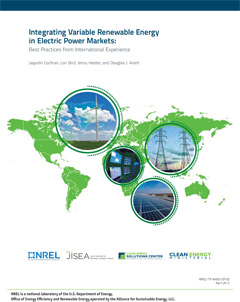12 April 2012
In Abu Dhabi, Paris, Davos, and New Delhi, the Clean Energy Solutions Center presented preliminary results of a high renewable energy penetration analysis that we developed in partnership with several international organizations and governments. The study focuses on best practices and case study comparisons from Australia, Denmark, Germany, Ireland, Spain and the United States.
The resulting report—Integrating Variable Renewable Energy in Electric Power Markets: Best Practices from International Experience and its companion Summary for Policymakers—synthesizes lessons on effective policies, regulations, planning, and practices for achieving and managing significant renewable energy penetration into large-scale electricity grid systems.
Goals
- Synthesize lessons on effective policies, regulations, planning, and practices for achieving and managing significant renewable energy penetration into electricity systems
- Highlight multiple approaches for achieving technical and institutional capabilities to accommodate renewable energy through case studies situated in diverse geographical, market, and institutional contexts
- Present to CEM-3 roundtable avenues for action that energy ministers and other stakeholders can pursue now to ensure that electricity markets and systems can effectively co-evolve with increasing penetrations of renewable energy.
Key Actions to Accommodate High RE Penetration
One outcome of these dialogues is an articulation of five actions that energy ministers and stakeholders can take to accelerate renewable energy penetration:
- Lead public engagement, particularly for new transmission
- Coordinate and integrate planning
- Develop rules for market evolution that enable system flexibility
- Expand access to diverse resources and geographic footprint of operations
- Improve system operations.
System-wide Approach to Areas of Intervention
The areas of intervention identified are distinct but interrelated; taking a system-wide approach ensures that not only are individual interventions more effective but also that the system as a whole will be more robust. The figure below shows one example of how each area of intervention might be related to others.

Experts Participating in This Initiative
Expert Group
- Brian Parsons, National Renewable Energy Laboratory (NREL)
- Adam Brown, International Energy Agency (IEA)
- Hugo Chandler, IEA and GIVAR project lead
- Hannele Holttinin, VTT Finland, IEA Task 25
- Peter Jørgensen, Energinet.dk
- Peter Meibom, Risø, Danish Energy Association
- David Pérez Méndez-Castrillón, Spanish Ministry of Industry, Energy, and Tourism
- Simon Mueller, IEA
- Mark O’Malley, Univ. College Dublin
- J. Charles Smith, Utility Variable Generation Integration Group
- David Swift, Australian Energy Market Operator
Advisory Group
- Douglas Arent, Joint Institute for Strategic Energy Analysis/NREL
- Morgan Bazillian, UNIDO & UNENERGY
- Paolo Frankl, IEA
- Ben Hobbs, Johns Hopkins University
- David Hurlbut, NREL
- Christine Lins, REN21
- Michael Liebreich, Bloomberg New Energy Finance
- Eric Martinot, Institute for Sustainable Energy Policies/Japan
- Hugh Outhred, University New South Wales
- Mark Radka, United Nations Environment Programme
- Ethan Zindler, Bloomberg New Energy Finance
Lead Analysts
Synthesis Paper: Jaquelin Cochran, Lori Bird, NREL
Case Studies
- Australia: Craig Oakeshott, SKM
- Denmark & Germany: Hugo Chandler, New Resource Partners
- Spain: David Pérez Méndez-Castrillón, Ministry of Industry, Energy, and Tourism
- U.S. & Ireland: Jenny Heeter, NREL

